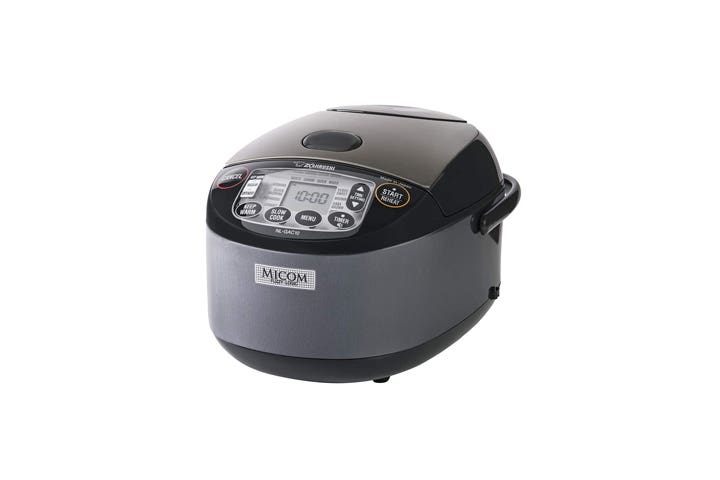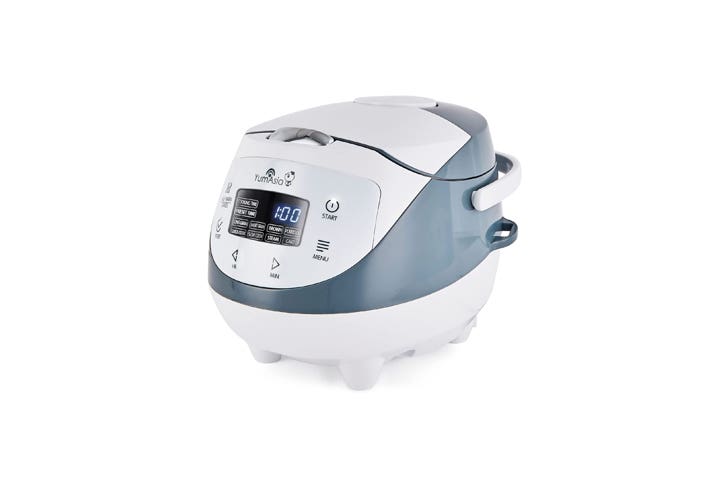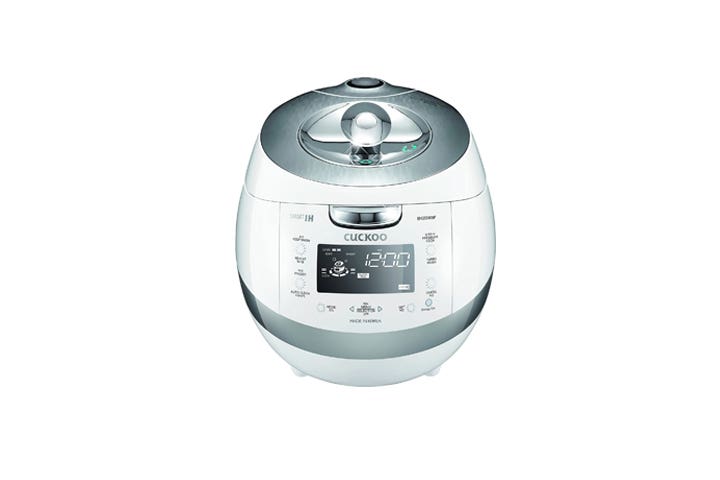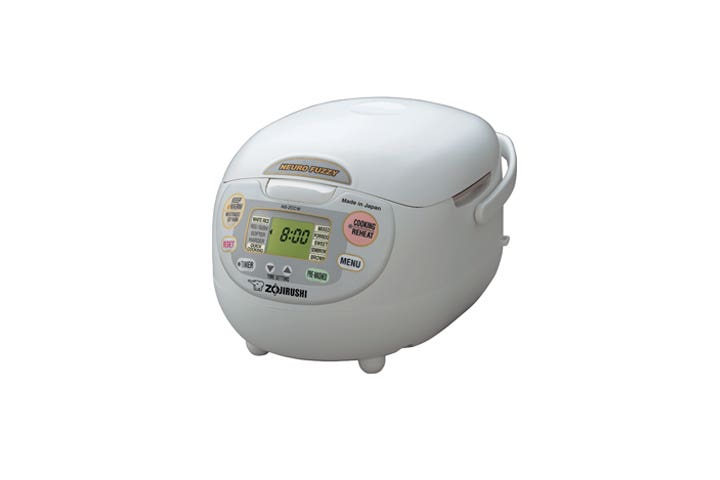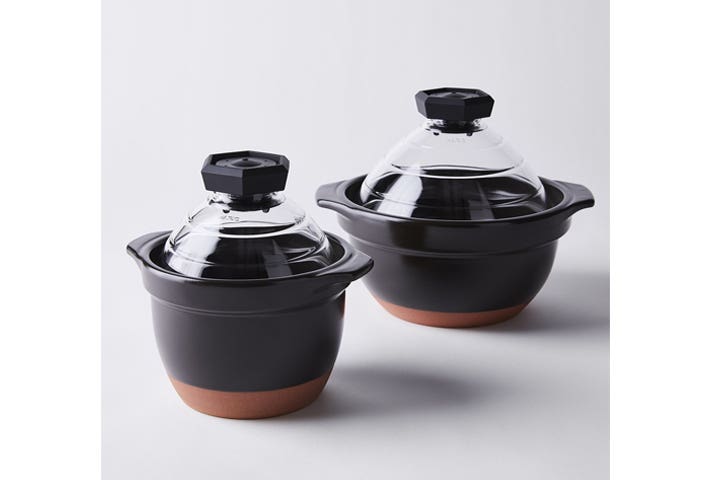Make Mountains of Fluffy Grains with the Best Japanese Rice Cookers
No more stovetop guesswork: These intuitive Japanese rice cookers produce melt-in-your-mouth grains at the push of a button.
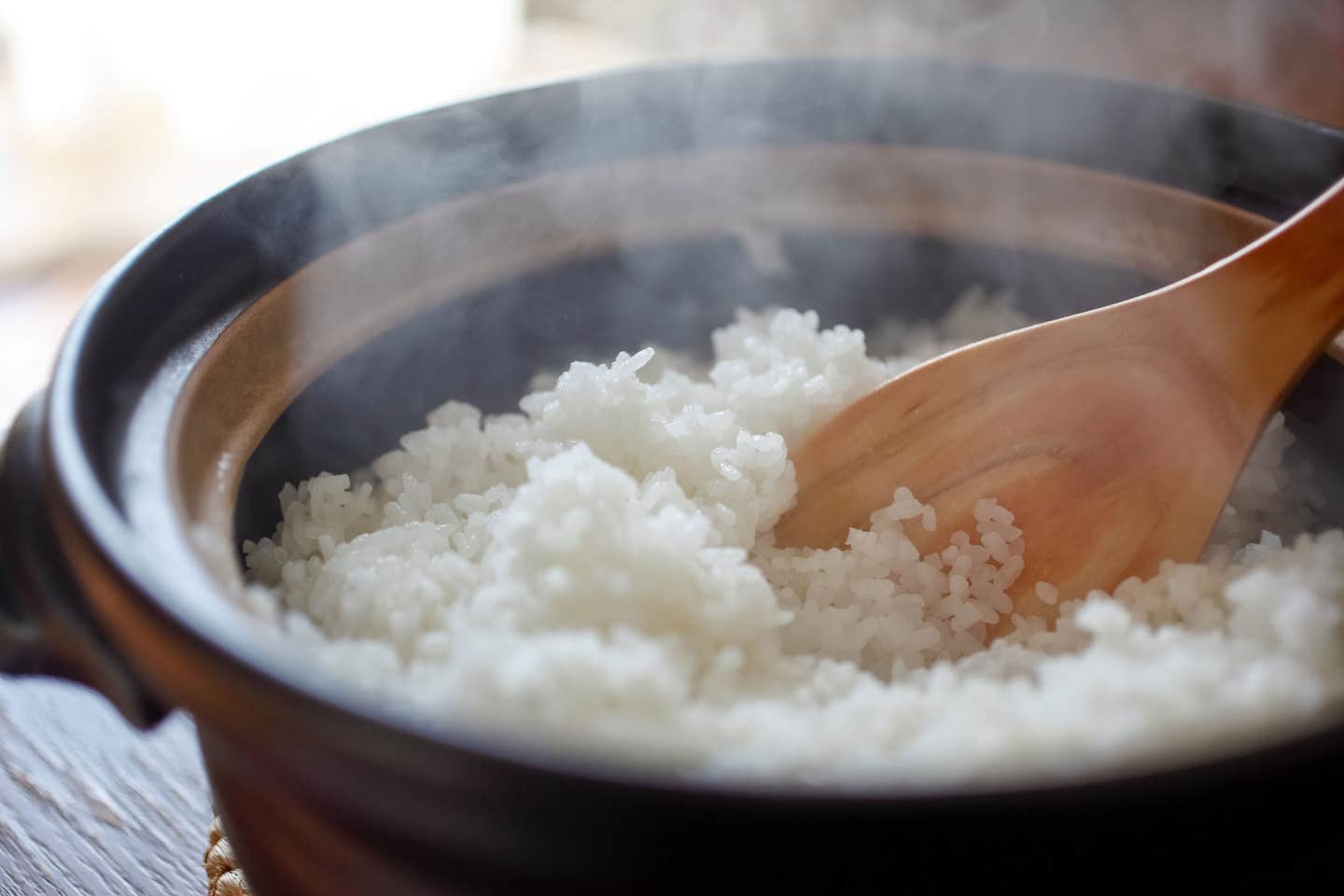
Raise your hand if you’re sick of your stovetop rice turning into a sticky, starchy, scorched mess—or just find the cooking process too time consuming and labor intensive. If this is you, it’s time to invest in one of the best Japanese rice cookers. While there's nothing wrong with a traditional rice cooker, which typically has a one-cooks-all setting, Japanese rice cookers are super intuitive–mitigating issues with mismeasuring and different cooking nuances. These machines adjust timing and temperature to accommodate whatever style of rice suits your next dinner; plus, the pressurized cooking method makes for extra-tender, fluffy rice. They’re kitchen multitaskers too. Toss in a few dumplings for a perfect steaming session, or even the egg custard chawanmushi—as chef Joanne Chang, the culinary force behind Boston’s Meyers & Chang and Flour Bakery, suggests. She’s our resident expert for this story and recalls a Tatung rice cooker as a prominent part of her childhood kitchen. Find the model that suits your kitchen (as well as some helpful shopping tips) below with our picks for the best Japanese rice cookers.
Our Top Picks
- Best Overall: Zojirushi NL-GAC10
- Best Value: YumAsia Panda Mini Rice Cooker
- Best Bells and Whistles: CUCKOO CRP-BHSS0609F
- Best for Cooking for a Crowd: Zojirushi Neuro Fuzzy Rice Cooker & Warmer, 10 Cup
- Best Analog: Hario GohanGama Japanese Rice Cooker Pot
Best Overall: Zojirushi NL-GAC10
Best Overall
Capacity: 5.5 cups | Dimensions: 9.1"D x 9.1"W x 9.1"H | Micom enabled/Fuzzy logic: Yes
Pros
- Numerous customizable settings
- Included dual warmer feature
- Simple interface
- Nonstick-coated interior vessel
Cons
- Higher price
- Not as suitable for larger batches
Why we chose it: With a setting for nearly every type of rice and other useful additions, this small-but-mighty machine makes the most tender, fluffy grains.
Zojirushi has been slinging top-notch Japanese rice cookers since they hallmarked the style in 1983, and this winning model is no exception. While you can’t really go wrong with any of the options offered by the brand, this one hits the sweet spot between the more expensive cookers and the simpler options (though we know it does sit closer to the pricey end of the spectrum). Plus, we can verify it churns out excellent rice tailored to the user’s preferences. Not only does it have specialized settings for jasmine, sweet, and brown rices, but the appliance also boasts unique cooking settings you can play around with along with the more standard warming and quick/slow cook modes. (We’re partial to the “umami” mode, which is designed to coax more flavor from your grains by soaking and steaming the rice longer.)
We also love the cook timer, which lets you time your rice perfectly with the rest of your dinner, and the low-touch experience of using this cooker. Simply use the interior bowl measurements to reach your desired amount, add the appropriate amount of water, and push a button. You’ll have nice rice in approximately 50 minutes. Bonus: When your rice has finished cooking, it’ll automatically shift into warming mode to keep your rice ready for second helpings.
Best Value: YumAsia Panda Mini Rice Cooker
Best Value
Capacity: 3.5 cups | Dimensions: 8.86"D x 11.81"W x 8.27"H | Micom enabled/Fuzzy logic: Yes
Pros
- Myriad settings for a small model
- 24-hour warming setting
- Easy cleanup
- Quick cooking
Cons
- Only available in small capacity
- Ceramic bowl coating could scratch easily
Why we chose it: This little powerhouse is the epitome of small, but mighty—precise functionality and a few useful bells and whistles for a more modest price.
This compact machine is a real workhorse—including just enough useful features to stand out without being overly complicated, and also clocking in on the lower end of the price spectrum for this souped-up style of rice cooker. From the outset, you can tell it is constructed with attention to detail in mind. There’s a handy built-in holder for your spatula to keep it clean and off the counter, as well as a transport handle that perfectly nestles into the cooker when not in use.
And these smart choices extend to the functionality of the machine, too. It has specialized settings for long and short grain rice along with some less run-of-the-mill choices. Rice cooker cake, anyone? One potential drawback for those with larger families: the capacity is one the small side. However, the size also helps the rice cook quicker, shaving off around 20 minutes compared to the standard 5.5-cup cooker. Once you have your moist and flavorful batch of rice cooked, you can use the extra-precise warming mode, which times by the minute rather than the hour as other models typically do. And with its rounded body shape and four nubby feet, this rice cooker looks really adorable sitting counterside.
Best Bells and Whistles: CUCKOO CRP-BHSS0609F
Best Bells and Whistles
Capacity: 6 cups | Dimensions: 10”H x 14.7”L x 10.6”W inches | Micon enabled/Fuzzy logic: Yes
Pros
- 16 different customizable settings
- Pressure cooking capabilities speed up cook time
- Auto adjusts during the cooking process
- Built-in voice guidance
Cons
- Expensive
- A little intimidating
Why we chose it: A smart algorithm makes the appropriate cooking adjustments to get fluffy rice every time, while high-end pressure cooking technology keeps things moving quickly without sacrificing quality.
There’s not much this R2-D2-like appliance can’t do (it can even talk you through the rice cooking process in three different languages). With 16 different settings, this cooker goes beyond just rice—with options to cook beans, reheat leftovers, and make bread—but of course, it also gets into the nitty-gritty of grain making, with a robust lineup of modes for different rice types. Though this might seem a bit intimidating, it’s actually rather intuitive. This rice cooker is enabled with a special algorithm that detects your grain type and works to maintain the proper internal temperature.
Other intelligently designed cooking features include: a controlled steam release that limits condensation, pressure cooking mode to promote consistency, and an induction-heated inner pot (forged from durable stainless steel and cloaked in a scratch-resistant nonstick coating, no less). Heating the pot rather than an external source helps distribute the heat more evenly across the bottom and sides of the vessel, so you won’t have to worry about some grains getting mushy and others staying crunchy. It also speeds things up, cooking white rice in around 20 minutes or so. Not to mention, there are safety features in place to regulate the heat and pressure inside the machine. And when you’re finished cooking, engage the automatic cleaning cycle with the touch of a button.
Best for Cooking for a Crowd: Zojirushi Neuro Fuzzy Rice Cooker & Warmer, 10 Cup
Best for Cooking for a Crowd
Capacity: 10 cups | Dimensions: 11" x 14¼" x 9½" | Micon enabled/Fuzzy logic: Yes
Pros
- Large size perfect for big families or celebrations
- Intuitive operation with automatic adjustments
- Retro aesthetic
- Retractable cord for simplified storage
Cons
- Slower cook time
- Hand-wash inner pot and lid
Why we chose it: This beloved fan-favorite cooker makes foolproof rice in big batches—now that it’s available in two times its original size.
This is the darling of Japanese rice cookers, so it’s no surprise it secured a spot on our “best” list. This model is simple, versatile, and—of course—produces soft grains with sweetness, nuttiness, and a touch of pleasant chewiness every time, even in a large volume (a rarity). It has settings for multiple types of rice, as many high-end cookers do (as well as congee and porridge settings), as well as one of the best “keep warm” functions around. This does wonders to maintain the quality rice it makes, and those used to preparing rice on the stovetop know it’s all too easy to end up with crusty grains after your cooking is complete. We adore the little melody this cooker plays when your rice is done, so you don’t have to keep checking the timer, and the candy-colored buttons and overall retro aesthetic of the thing.
The retractable cord and inner pot handles also add a little more finesse to your rice cooking experience, along with the extremely clear measurements markings on the pot’s interior. It can be a bit fickle to clean, as you must hand-wash the lid interior and pot, and overall cooks rice on the slower side than other models, a bit under double the time. But consistency is key when it comes to rice cookers, and aren’t good things worth waiting for?
Best Analog: Hario GohanGama Japanese Rice Cooker Pot
Best Analog
Capacity: Small: 1.5 cups Large: 2.25 cups | Dimensions: Small: 7.00" D x 8.00" L x 7.00" H; Large: 9.00" D x 11.00" L x 8.00" H | Micon enabled/Fuzzy logic: No
Pros
- Heat-resistant lid
- Available in small or large sizes
- Stunning stoneware look
- Soft whistle sound indicates cooking completion
Cons
- Expensive
- Small option very small; large option also small
Why we chose it: Made in Japan from traditional Banko ware, this sweet little pot cooks rice quickly and efficiently on the stovetop (and looks great doing it, too).
We know Japanese rice cookers are famed for their smart technological capabilities and hands-off cooking experience, but we couldn’t resist including this pot-style rice cooker made in Japan for cooks looking for a digital detox. You might be familiar with Japanese brand Hario for their iconic gooseneck kettle and coffee equipment, but their culinary reach extends much further. Hario is the only heat-proof glass factory in Japan and has been producing top-notch products for over a century, so it’s no surprise that the glass lid on this earthy ceramic rice pot is nearly indestructible (and a great way to keep an eye on your rice as it simmers away). The body is crafted from Japanese Bankoware, a type of pottery originally made for tea and known for its consistent heat-holding and rich rust hue. It's equipped with thoughtful features like an internal measuring guide, a steam vent to prevent starchy overflow splashes, and handy helper handles on each side covered in heat-resistant silicone. Both pots are quite small, but if you’re cooking for one or two people it shouldn’t be an issue, since the petite stature of these pots help them cook rice in around 15 minutes. And though it's entirely analog, this cooker is not without its “automatic” features, so to speak. The pot makes a light whistling sound when your rice is done, akin to a less-aggressive tea kettle.
Things to Consider Before Buying a Japanese Rice Cooker
Material
Chef Chang recommends opting for a model with parts crafted from stainless steel so they can hold up to years of frequent use. Aluminum is another common material used to construct rice cookers, but it’s much more flimsy and prone to warping over time. Many cookers also have a nonstick coating on their interior pots, which is a godsend for preventing clumpy, crusty rice.
Capacity & Size
If you’re buying a rice cooker in the first place, it’s probably safe to assume you cook/eat quite a bit of rice. But the size of your household (and the size of your kitchen) both might influence the capacity of cooker you need. Rice cookers are usually marked by the dry cup amount, and that usually doubles or triples once it’s cooked. Note: A rice cooker’s “cup” is not the same as the standard cup we’re used to cooking with. While a metric cup measures 240ml, a rice cooker’s cup clocks in at around 180ml. Keep this in mind when choosing and using your rice cooker. The good news is the measuring cup that comes with the appliances is suited toward the Japanese measurement, so there won't be much guesswork.
Pre-Sets
If you’ve already chosen to go for a Japanese-style rice cooker over a simpler traditional model, chances are you’re eager for a more “smart” experience that can be tailored to your preferences and different varieties of rice. Most options include settings designed for this, so if you’re someone who prefers a nutty, chewy brown rice over its fluffy white counterpart, you should keep an eye out for a rice cooker with a designated brown rice setting. More tricked-out models might include buttons for reheating rice and even quick (pressure cook) and slow cooking options to perfectly time your rice to be finished with the rest of your meal.
Special Features
Our article expert, chef Joanne Chang, says a warmer is her most essential feature when it comes to a rice cooker. It’ll keep your rice not only warm, but also fresh (no crusty grains here) until you’re ready to serve it. Most Japanese models will include “neuro fuzzy” or “micom” technology, which programs your cooker to be sensitive to factors like water level and temperature if they change throughout the cooking process. Most options will also include a rice paddle and a measuring cup, and some very elite models will have an auto clean function (as if cooking with one of these babies couldn’t get any easier).
FAQs
What defines a Japanese rice cooker?
By definition, a Japanese rice cooker is any rice cooker that is made in Japan. But more often, the term is used to describe high-tech models that specialize in quick cooking and include myriad additional features in contrast to a traditional cooker’s simple bucket heater, pot insert and lid. (And yes, there are many brands not made in Japan but still considered Japanese rice cookers).
What is the ideal capacity of a Japanese rice cooker?
As touched on in the “things to consider” section above, the typical capacity of a Japanese rice cooker is around 5.5 cups (which will yield enough rice for around 3-5 good servings), but obviously it’s smart to go larger or smaller depending on your cooking habits (are you a meal prepper or someone who cooks for crowds often?). Keep in mind, rice cookers typically are at least medium-sized appliances, so consider your kitchen space and storage limits before you choose a model.
How many different settings does a Japanese rice cooker have?
By definition, Japanese rice cookers tend to have more elaborate settings than traditional models. While the exact number ranges from product to product, we found most options have multiple settings for cooking different types of rice (from white, to brown, to Jasmine) with some even including auto functions for preparing congee and porridge. Additional settings for warming or slow cooking are common in quality cookers as well.
What else can I use Japanese rice cookers for?
In addition to making more simple, straightforward dishes like porridge and dumplings, Chang says: “You can use the rice cooker as a steamer for other foods not just for rice. With eggs, you can make chawanmushi (a steamed egg custard with mushroom, scallion, and soy that’s a traditional Japanese breakfast and a delicious snack). You can also marinate chicken or pork in sake and salt and pepper and steam in the rice cooker for a simple main course when you don't want to saute or fry or bake. Be sure to follow the instructions on the rice cooker for the water to rice proportion.”
Final Thoughts
All of the best Japanese rice cookers showcased on this list will offer you tender, fluffy grains with minimal guesswork and hands-on work. The best option to suit your kitchen largely depends on the space you have, frequency you'll use it, and if you’re loyal to one type of rice or many. Since Japanese rice cookers often run expensive, since they’re equipped with so many smart features, we love the Zojirushi NL-GAC10, which offers just enough little luxuries in a compact, user-friendly package. Regardless of which model you go with, you’re sure to have great grains ahead.
Methodology
Japanese rice cookers are all about the features, so useful settings and high-tech capabilities were the factors we considered first and foremost when deciding which models made it on our winners list. We began with checking in with chef Joanne Chang of Boston’s Meyers & Chang restaurant to glean some initial rice cooker intel before sifting through the offerings from Zojirushi. This company pioneered the Japanese rice cooker in the early 1980s and we knew they’d have some options that would find a home in our “best” list. We then moved on to other brands both small and large to get a better sense of which ones are popular in the market and if their products stack up to their reputations. Japanese rice cookers are also known for being on the expensive side, given all of the included bells and whistles, so we also aimed to include a range of prices while still keeping quality in mind. Durability played an important part in our decision making, too. We’ve heard of rice cookers becoming kitchen heirlooms and, to make sure our picks would function for decades, chose those with components constructed from sturdy stainless steel (our expert’s recommendation).
Every product is independently selected and vetted by editors. Things you buy through our links may earn us a commission.
Keep Reading
Continue to Next Story
